Khaled Abdul-Aziz Ahmed1,2*, Ola AL-Sanabra3 , Amal Haidar4, Sahar Eskander4, Belqees Al-qiari4, Aqdar Hamzah4, Samah Mahdi4 and Ghada Al-Assi1
, Amal Haidar4, Sahar Eskander4, Belqees Al-qiari4, Aqdar Hamzah4, Samah Mahdi4 and Ghada Al-Assi1
1Department of Medical Laboratory Sciences, Faculty of Allied Medical Sciences, Al-Ahliyya Amman University, Amman 19328, Jordan.
2Pharmacological and Diagnostic Research Centre, Al-Ahliyya Amman University, Amman 19328, Jordan.
3Department of Medical Analysis, Faculty of Science, Al-Balqa Applied University, Alsalt, Jordan.
4Department of Microbiology, Faculty of Science, Ibb University, Ibb, Yemen.
Corresponding Author E-mail: khaaah@gmail.com
DOI : https://dx.doi.org/10.13005/bpj/2354
Abstract
The purpose of this study is to evaluate the role of wet cupping in improving the kidney function tests, hematological parameters and lipid profile in adult women. Blood samples were collected and used for measuring uric acid, creatinine, urea, glucose, triglyceride, cholesterol, HDL cholesterol, LDL cholesterol and complete blood cell (CBC) counts. The necessary calculations were done to estimate the unmeasured parameters. The study subjects for body mass index showed that most of these women were overweight to obese. After about 2 weeks of doing wet cupping, 92% of the individuals were feeling good as compared with their condition before performing of wet cupping. The results have shown a significantly increased in the percentage of lymphocytes and platelets count due to blood cupping. Alongside, the results have revealed that creatinine and urea levels were significantly reduced post-cupping as compared to values seen in pre-cupping. Additionally, statistical significant reduction was observed in the triglyceride levels and triglyceride/HDL-cholesterol and LDL/HDL-cholesterol ratios in the women after cupping in comparison to that seen cupping. It can be concluded that wet cupping as a one of the traditional medicine can be safely used for reducing the risks of kidney disorders and cardiovascular diseases risks.
Keywords
Hematological Parameters; Kidney function; Lipid profile; Wet cupping
Download this article as:| Copy the following to cite this article: Ahmed K. A. A, Sanabra O. A, Haidar A, Eskander S, Al-qiari B, Hamzah A, Mahdi S, Al-Assi G. Evaluating the Therapeutic Effects of Wet Cupping (Al-Hijamah) on Hematological Parameters, Kidney Function Tests and Lipid Profile in Adult Women. Biomed Pharmacol J 2022;15(1). |
| Copy the following to cite this URL: Ahmed K. A. A, Sanabra O. A, Haidar A, Eskander S, Al-qiari B, Hamzah A, Mahdi S, Al-Assi G. Evaluating the Therapeutic Effects of Wet Cupping (Al-Hijamah) on Hematological Parameters, Kidney Function Tests and Lipid Profile in Adult Women. Biomed Pharmacol J 2022;15(1). Available from: https://bit.ly/36Me0Kf |
Introduction
Recent studies have shown an increase in the number of people who are suffering from certain diseases that need an enormous effort for diagnosis and treatment1, 2. Cardiovascular diseases (CVDs) are an example of these diseases which are worldwide occupying the second rank in their mortality and morbidity rate3, 4. Thus, many efforts are still spending for minizine the rate morbidity and morbidity of CVDs including identifying the risk factors of CVDs as well as finding methods to minimize these factors in order to avoid their life-threatening effects. However, some of these methods have shown challenges like their complexity to be performed5, 6. It could be difficult for some patients to have such treatment due to their poor socioeconomical status.6 Also, some patients have a strong believes and confidence in the efficient of complementary medicine as a treatment7. So, nowadays in different communities treatment of different diseases such as backpain, infertility, liver diseases, hypertension and viruses infection for example herpes simplex infection depends on complementary medicine such as wet cupping 8-12.
Wet cupping procedure is drawing blood in a cup after performing an incision by using sterile blade on the vacuumed targeted skin area either by mechanical withdraw or thermal cooling or applying of flaming on this area. The cup is used to facilitate suction in this specific point in patient’s body13. By practicing this method the health of the patients are improved due to its ability to make muscles relaxation, increasing blood flow, removing toxic material from the patient’s body, and enhancing immune system13-16. Wet cupping (Al-Hijamah) is one of an ancient methods of complementary medicine that was used by different cultures such as Chinese, Greek, and Arabic populations17-19. Recently, this method was implemented in special clinics for treatment of patients with various diseases in different areas of the world such as: Britain, Arab countries such as Saudi Arabia and Kuwait, and in Iran20-24. Despite a number of studies covering the effect of wet cupping in men biometrics as well as improving women fertility. However, no study tackle the effect of wet cupping on adult women biometrics. Thus, the objective of this study is to evaluate the effect of wet cupping on results of hematological parameters, kidney function tests and lipid profile in adult women.
Materials and Methods
Study participants
The study was conducted on a group of women randomly selected from different national therapy centers in Ibb city where women visit for cupping therapy. Women were selected from those who attending Al-Amal Center for Natural Therapy at Al-Udain round (West Ring Road). Other participants were also selected from Al -Hayat Center for Natural therapy, Al-Udain Street branch, and Taiz Street Branch, Ibb city. These women were between (20 – 60) years old. They were treated with cupping for different etiologies including neck, waist, and back pain, rheumatoid arthritis, health improvement (protection), headache, and some other diseases such as hypertension, varicose, and diabetes. The number of selected women was 106 cases; however, about 31 cases were excluded from the study for different reasons mainly because they do not complete at least one cupping center visit.
The rest of the study participants (75 women) have been included in the study on the basis that they agreed to attend the interview and completed a prepared questionnaire and their body weight and height were taken to calculate the body mass index (BMI) before performing wet cupping procedure. From these cases two blood samples were taken. The first sample was taken before cupping (pre-cupping), while the second sample was taken after cupping (post-cupping) with a period between 10 -14 days. Urine samples were also collected for qualitative analysis. The mean reason for Al-Hijamah (cupping) done is basically religious since the highest number of cases that visit the cupping centers is in 17th, 19th and 21st of the Islamic calendar.
Cupping process
Al-Hijamah was done for the women by the following steps: At first, each woman was subjected for cupping process by placing a special cup that has a valve on its back or on any sit according to type of treatment that connect by screw with vacuum pump to make a negative pressure inside a cup which placed on skin of back’s person for about 5-10 min where the skin becomes inside the cup. After that the cup was removed and many incisions were made on the unsensitized skin by sterilized scalpel, so when blood rush out, the cup was replaced again and made a negative pressure by manual vacuum pump and leave the cup to collect blood. When rushing of blood stopping, the cup was removed and this take a period approximate by 15-30 minutes. Finally, a necessary dressing for wounds was made for each person.
Blood sampling
Blood samples were taken in the morning between 8:00 and 12:00 a.m. after an overnight (10-12 hours) fast from all subjects. Blood samples were collected from each participant in two tubes, 2.5 ml in K2-EDTA (1 mg/ml) tubes to perform hematological parameters measurement and 2.5-3 ml in plain tubes. Blood samples in the plain tubes were centrifuged at 3000 xg for 10 minutes at room temperature within 60 min after collection and the serum was stored at -20oC for biochemistry measurements including uric acid, creatinine, urea, glucose, triglyceride, cholesterol, and HDL cholesterol.
Biochemical analysis
Uric acid, creatinine, urea, glucose, triglyceride, cholesterol and HDL cholesterol were measured by using Biosystems spectrophotometer (BTS-350, Germany). For uric acid and urea measurements kits were purchased from Spinreact (Spain). LDL-cholesterol levels were estimated by using Friedewald formula25. Creatinine, triglyceride and glucose tests kits were purchased from Linear Chemicals (Spain) while, cholesterol and HDL-cholesterol tests kits were purchased from Quimica Clinica Aplicada (Spain). Urine stripes were provided from Uriscan, BioSys Laboratories (USA).
Hematological analysis
Collected K2-EDTA blood samples were used to evaluate the hematological parameters (red blood cell (RBC) count, hemoglobin (Hb), white blood cell (WBC) count, differential white blood cells and platelets count) by applying them to hematological analyzer (Sysmex KX-21N, model 3500, Kobe, Japan). Other RBCs indices were also measured such as packed cell volume (PCV), mean corpuscular volume (MCV), mean corpuscular haemoglobin (MCH) and mean corpuscular haemoglobin concentration (MCHC).
Statistical analysis
Statistical analysis was performed by using statistical software package (SPSS version 22). The qualitative data were expressed as a number and percentage. Chi-square was used as a test of significance for qualitative data. Paired test was used to study the significance of quantitative data. Pearson’s correlation coefficient analysis was used where appropriate. The data were significance if P value is < 0.05.
Results
Reasons of performing wet cupping procedure for the study participants
A total of and completed the prepared questionnaire were included in this study. Of the 75 adults women who met the study criteria, 3 cases who attended the cupping centers for joint pain relief were excluded from this study. The remaining 72 were subjected for quantitative measurements before and after cupping. Fig. 1 illustrates the different reasons for visiting cupping centers by the study participants. Our findings showed that the most reason for doing cupping is musculoskeletal problems (neck, waist, and back pain) with 57% of all women. All participants were asked to visit the cupping centers for follow up. After about 2 weeks of doing cupping, 92% of the individuals were feeling good after cupping as compared with their condition before cupping (Fig. 2). Of the study individuals, 82 % were married, 49% housewives, and 86% were non- smokers.
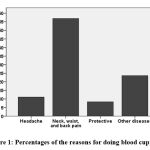 |
Figure 1: Percentages of the reasons for doing blood cupping. |
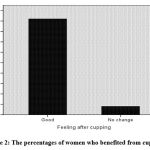 |
Figure 2: The percentages of women who benefited from cupping. |
Effect of wet cupping on kidney function tests
The major biochemical parameters of the study individuals are shown in Table 1. The mean age of the participants was (36.6 ± 10.9) years old. It has been revealed that creatinine and urea levels were markedly and significantly reduced in comparison with values before and after cupping, 0.86 ± 0.15 vs. 0.75 ± 0.18 (P <0.001) and 33.62 ± 10.56 vs. 31.07 ± 10.88 (P = 0.016), respectively (Table 1). Uric acids levels were not significantly different in the individuals before and after blood cupping. Qualitative urine analysis was performed and showing normal results. However, proteinuria was observed in 14.9% cases in the first visit and 4.9% in the second visit (Fig. 3).
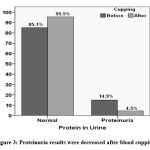 |
Figure 3: Proteinuria results were decreased after blood cupping. |
Effect of wet cupping on lipids profile
The results of body mass index (BMI) revealed that most of these women were overweight to obese (29.99 ± 1.14). BMI values were divided into three groups; women with BMI below 18.5 (underweight), with BMI 18.5-24.9 (normal), and those with BMI ≥ 25 representing overweight and obese women. Proportion of overweight and obese women (71.6%) was higher than proportion of those individuals with BMI < 25 (28.4%) and the difference was significant (P<0.001) (Fig. 4). A statistical significant reduction was observed in the triglyceride levels and triglyceride/ HDL- cholesterol and LDL/HDL-cholesterol ratios in the women after cupping as compared to their states before cupping. On the other hand, HDL/LDL-cholesterol ratio and HDL-cholesterol levels were dramatically and significantly increased after cupping. There were no significant differences in the levels of serum glucose, cholesterol, LDL- cholesterol, and cholesterol /HDL-cholesterol ratio between the two (before and after) visits (Table 1).
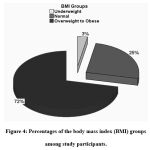 |
Figure 4: Percentages of the body mass index (BMI) groups among study participants. |
Table 1: Comparison of biochemical parameters between before and after cupping therapy
| Biochemical parameters | Before cupping | After cupping | P value |
| Glucose (mg/dL) | 105.9 ± 40.1 | 114.9 ± 37.6 | 0.137 |
| Urea (mg/dL) | 33.62 ± 10.56 | 31.07 ± 10.88 | 0.016* |
| Uric acid (mg/dL) | 4.3 ± 1.51 | 3.81 ± 1.86 | 0.096 |
| Creatinine (mg/dL) | 0.86 ± 0.15 | 0.75 ± 0.18 | <0.001* |
| Triglycerides (mg/dL) | 126.27 ± 51.47 | 102.63 ± 46.13 | 0.006* |
| Cholesterol (mg/dL) | 187.51 ± 52.44 | 181.64 ± 52.36 | 0.518 |
| HDL-Cholesterol (mg/dL) | 39.98 ± 8.29 | 45.67 ± 8.49 | <0.001* |
| LDL-Cholesterol (mg/dL) | 122.38 ± 50.05 | 106.25 ± 45.87 | 0.054 |
| Triglyceride/ HDL-Cholesterol | 3.13 ± 1.23 | 2.39 ± 1.16 | 0.001* |
| Cholesterol /HDL-cholesterol | 4.68 ± 1.56 | 4.22 ± 1.51 | 0.079 |
| LDL/HDL-Cholesterol | 3.12 ±1.57 | 2.58 ± 1.37 | 0.035* |
| HDL/LDL-Cholesterol | 0.39 ± 0.22 | 0.64 ± 0. .30 | 0.038* |
Values are mean ± standard deviation (SD). *Significantly different between the two visits (before and after cupping) because P value was < 0.05.
Correlations studies of lipids parameters after blood cupping
Pearson’s correlation coefficients of cholesterol and LDL-cholesterol with other ratios were determined. LDL/HDL-cholesterol was significantly and positively correlated with cholesterol and LDL-cholesterol levels; r = 0.644, P < 0.001 and r = 0.83, P < 0.0001, respectively (Fig. 5). Furthermore, Fig. 6 revealed that the decreased in cholesterol and LDL-cholesterol levels were significantly correlated with the increased HDL/LDL-cholesterol; r = – 0.497, P < 0.001 and r = -0.545, P < 0.001, respectively.
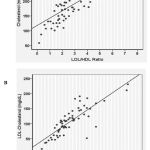 |
Figure 5: Scatter plots showing the positive relationships between LDL/HDL-cholesterol and levels of cholesterol (A) and LDL-cholesterol (B). |
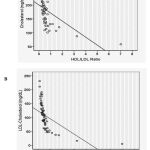 |
Figure 6: Scatter plots showing the negative correlation between HDL/LDL-cholesterol and levels of cholesterol (A) and LDL-cholesterol (B). |
Hematological characteristics
The findings revealed an increased significantly in the percentage of lymphocytes and platelets count due to blood cupping (Table 2). On the other hand, there were no significant differences in in the WBCs count and RBCs indices (RBCs count, hemoglobin, PCV, MCV, MCH, and MCHC) before and after bleeding by cupping.
Table 2: Effect of blood cupping on hematological indices
| Hematological Parameters | Before cupping | After cupping | P value |
| Platelets (X109/l) | 263.9 ± 70.5 | 294.24 ± 65.0 | 0.011* |
| WBCs (X109/l) | 5.56 ± 1.82 | 5.28 ± 1.49 | NS |
| Lymphocytes (%) | 40.79 ± 9.71 | 44.77 ± 9.57 | 0.018* |
| RBCs (X1012/l) | 5.015 ± 0.44 | 4.96 ± 0.39 | NS |
| Hemoglobin (g/dl) | 13.39 ± 1.94 | 13.44 ± 1.39 | NS |
| PCV (l/l) | 41.96 ± 3.05 | 41.46 ± 2.67 | NS |
| MCV (fl) | 83.77 ± 5.92 | 83.06 ± 8.02 | NS |
| MCH (pg) | 26.89 ± 2.44 | 26.83 ± 2.32 | NS |
| MCHC (g/dl) | 31.89 ± 1.17 | 32.03 ± 1.33 | NS |
Values are mean ± standard deviation (SD). *Significantly different between the two visits (before and after cupping) because P value was < 0.05. NS; the difference between groups is not significant.
Discussion
Pain is the most common reason for seeking therapeutic alternatives to conventional medicine and the more severe the pain, the more frequent is the use of such therapies26, 27. Cupping is a physical treatment used by acupuncturists or other therapists, which utilize a glass or bamboo cup to create suction on the skin over a painful area or acupuncture point28. It is mostly used in Asian and Middle Eastern countries and has been claimed to reduce pain as well as a host of other symptoms29. It has also been used to treat other nonspecific disease processes including indigestion and menstrual disturbance30.
A recent systematic review included five trials [two randomized clinical trials (RCTs) and three controlled clinical trials (CCTs)] on the effects of wet cupping on musculoskeletal problems18. In our study, Fig. 2 revealed that wet cupping used in this study is effective for treating chronic pain including waist, neck, and back pain as well as headache. In other words, results showed that the women given cupping treatment experienced a highly significant decrease in pain and other symptoms with 92% of cases showed positive results. The data suggest effectiveness of cupping compared with conventional treatment31.
In the present study, wet cupping significantly reduced the creatinine levels after about 2 weeks from cupping (P<0.001). Although there were no changes in the uric acid levels, the urea levels were also significantly reduced after cupping (P=0.016). The reduction in urea and creatinine levels thus makes the wet cupping a potential therapeutic tool for improvement of kidney functions. This is consistent with Husain et al. study which has shown a similar result32.
Because of the high rate of complications and limited efficacy of drugs in the definitive treatment of chronic diseases, the use of traditional medicine is becoming increasingly widespread. It has been described the use of both wet and dry cupping in the treatment of a variety of diseases17, 33. Many physicians believe that cupping is a preventive approach against some cardiovascular diseases34. High serum cholesterol is an important risk factor in the incidence of cardiovascular disease35. It is recognized that during cupping, cholesterol levels in the released blood are significantly higher than levels in the venous blood36.
Urea, triglycerides and uric acid in the cupping blood were significantly higher than in the venous blood13. Furthermore, subjects who frequently donated blood had a significant reduction in the level of serum cholesterol, and a lower risk of cardiovascular incidents was found among blood donors37. A previous randomized clinical trial suggested that wet cupping may be an effective therapy for reduction of LDL-cholesterol concentrations and consequently may have a protective effect against atherosclerosis36. The results of body mass index (BMI) revealed that most most of the women participated in this study (72%) are overweight to obese women indicating the abnormalities in the blood lipids in those women.
Because of the preventive effects of lipoprotein-lowering trials on atherosclerosis progression38, the present study was also conducted to investigate the effects of wet cupping as a method of bloodletting on serum lipids including triglycerides, cholesterol, LDL-cholesterol, and HDL-cholesterol levels. As revealed in Table 1, cupping causes a significant reduction in triglycerides levels (P=0.006) and increase in HDL-cholesterol concentrations (P<0.001).
Although there were decrease in cholesterol and LDL-cholesterol levels after cupping, the differences were not statistically significant. This is not consistent with the previous study which showed that blood cupping causes a decrease in cholesterol and LDL-cholesterol levels36. Therefore, to minimize this controversy, important calculations were made such as cholesterol/HDL-cholesterol, HDL/LDL-cholesterol, triglyceride/DL-cholesterol, and LDL/HDL-cholesterol ratios. These ratios are commonly used in the literature as atherogenic indices. The results of the study have also shown that wet cupping is an effective method in reducing the triglyceride/HDL-cholesterol (P=0.001) and LDL/HDL-cholesterol ratios (P=0.035). Furthermore, HDL/LDL-cholesterol ratio was increased significantly after cupping as compared before cupping. Wet cupping did not show a significant influence on cholesterol/HDL-cholesterol ratio. Correlation studies using Pearson’s correlation coefficients analysis showed a positive and significant correlation between LDL/HDL-cholesterol with cholesterol and LDL-cholesterol levels (Fig. 5) and negatively correlated with HDL/LDL-Cholesterol (Fig. 6). All high-risk patients with LDL-cholesterol >100 mg/dL should be treated with drug therapy with the goal of reducing LDL-cholesterol to <100 mg/dL39.
The hemostatic ability of cupping is evidenced in its ability to significantly reduce bleeding time.15 This is confirmed by the increase in platelet count. In our study, it has been observed in Table 2 that the platelet count is increased after blood cupping significantly (P=0.011). Thus, cupping has hemostatic effect (increase in platelet count that is critical to the formation of hemostatic plugs which function to enhance clotting and prevent blood loss). Table 2 has also showed an increase in lymphocyte percentage after cupping when compared to their values before cupping. Thus, the immune system might probably have been stimulated, including the production of antibodies just like in the hypercholesterolemic rats40. There were no significant differences in the other hematological parameters including RBCs indices and WBCs count between before and after blood cupping.
The majority of women who feel better after suggest a favorable effect of wet cupping for reducing pain, especially headache and musculoskeletal pain. From the quantitative results, it can be concluded that wet cupping as a traditional medicine can be used for reducing the risks of kidney disorders as explained by decreased levels of creatinine after cupping. Furthermore, wet cupping may be an effective method of increasing HDL cholesterol and consequently may have a preventive effect against atherosclerosis. Correlation analysis results confirm the effectiveness of wet cupping in reducing the atherogenic indices in these women.
Acknowledgement
The authors are grateful for payment of the publication charge offered by Al-Ahliyya Amman University /Jordan. Corresponding author would like to thank International Institute Education – Scholar Rescue Fund (IIE-SRF) program for awarding the fellowship at Al-Ahliyya Amman University.
Conflict of interest
The authors declare no conflict of interest.
Funding Sources
There is no funding source.
References
- Engel N, Wachter K, Pai M, Gallarda J, Boehme C, Celentano I, Weintraub R. Addressing the challenges of diagnostics demand and supply: insights from an online global health discussion platform. BMJ Global Health. 2016; 1(4): e000132.
CrossRef - Graber ML. The incidence of diagnostic error in medicine. BMJ Quality and Safety. 2013; 22(Suppl 2): ii21-ii27.
CrossRef - Mensah GA, Roth GA, Fuster V. The global burden of cardiovascular diseases and risk factors: 2020 and beyond. Journal of the American College of Cardiology. 2019; 74(20): 2529-32.
CrossRef - Roth GA, Mensah GA, Johnson CO, Addolorato G, Ammirati E, Baddour LM, et al. Global burden of cardiovascular diseases and risk factors, 1990–2019: update from the GBD 2019 study. Journal of the American College of Cardiology. 2020; 76(25): 2982-3021.
CrossRef - Patel KC, Minhas R, Lincoln P, Dhillon RK. Strategic challenges in the prevention of cardiovascular disease. Journal of the Royal Society of Medicine. 2008; 101(3): 105-107.
CrossRef - Gupta R, Yusuf S. Challenges in management and prevention of ischemic heart disease in low socioeconomic status people in LLMICs. BMC Medicine. 2019; 17(1): 1-11
CrossRef - Zörgő S, Peters GJ, Mkhitaryan S. Attitudes underlying reliance on complementary and alternative medicine. Integrative Cancer Therapies. 2020; 19. doi: 10.1177/153473542091047
CrossRef - Ahmed NZ, Anwar N, Begum S, Parvez A, Ezhil R, Anjum N. Effect of Hijama (wet cupping), Dalk (massage) & Bukhūr (medicated steam) in amelioration of Waja al-Zahr (non-specific low back pain)- A n open prospective clinical trial. Journal of Complementary and Integrative Medicine. 2021; Online ahead of print.
CrossRef - Wang JX, Yang Y, Song Y, Ma LX. Positive effect of acupuncture and cupping in infertility treatment. Medical Acupuncture. 2018; 30(2): 96-99.
CrossRef - Bashiri H, Bozorgomid A, Shojaeimotlagh V. Efficacy of Hijamat (wet cupping therapy) in Iranian patients with nonalcoholic fatty liver disease: a controlled clinical trial. Turkish Journal of Medical Sciences. 2020; 50(2): 354-359.
CrossRef - Lu S, Du S, Fish A, Tang C, Lou Q, Zhang X. Wet cupping for hypertension: a systematic review and meta-analysis. Clinical and Experimental Hypertension. 2019; 41(5): 474-480.
CrossRef - Cao H, Zhu C, Liu J. Wet cupping therapy for treatment of herpes zoster: a systematic review of randomized controlled trials. Alternative Therapies In Health And Medicine. 2010; 16(6): 48-54.
- Al-Bedah AM, Elsubai IS, Qureshi NA, Aboushanab TS, Ali GI, El-Olemy AT, et al. The medical perspective of cupping therapy: Effects and mechanisms of action. Journal of Traditional and Complementary Medicine. 2019; 9(2): 90-97.
CrossRef - Wang X, Zhang X, Elliott J, Liao F, Tao J, Jan YK. Effect of pressures and durations of cupping therapy on skin blood flow responses. Frontiers in Bioengineering and Biotechnology. 2020; 8. doi: 10.3389/fbioe.2020.608509
CrossRef - Umar NK, Tursunbadalov S, Surgun S, Welcome MO, Dane S. The effects of wet cupping therapy on the blood levels of some heavy metals: a pilot study. Journal of Acupuncture and Meridian Studies. 2018; 11(6): 375-379.
CrossRef - Baghdadi H, Abdel-Aziz N, Ahmed NS, Mahmoud HS, Barghash A, Nasrat A, et al. Ameliorating role exerted by Al-Hijamah in autoimmune diseases: effect on serum autoantibodies and inflammatory mediators. International Journal of Health Sciences. 2015; 9(2): 207–232.
CrossRef - Cao H, Han M, Li X, Dong S, Shang Y, Wang Q, et al. Clinical research evidence of cupping therapy in China: a systematic literature review. BMC Complementary and Alternative Medicine. 2010; 10(1): 1-10.
CrossRef - Aboushanab TS, AlSanad S. Cupping therapy: an overview from a modern medicine perspective. Journal of Acupuncture and Meridian Studies. 2018; 11(3): 83-87.
CrossRef - Qureshi NA, Ali GI, Abushanab TS, El-Olemy AT, Alqaed MS, El-Subai IS, et al. History of cupping (Hijama): a narrative review of literature. Journal of Integrative Medicine 2017; 15(3): 172-181.
CrossRef - Sajid MI. Hijama therapy (wet cupping)–its potential use to complement British healthcare in practice, understanding, evidence and regulation. Complementary Therapies in Clinical Practice. 2016; 23: 9-13.
CrossRef - Khalil MK, Al-Eidi S, Al-Qaed M, AlSanad S. Cupping therapy in Saudi Arabia: from control to integration. Integrative Medicine Research. 2018;.7: 214-218.
CrossRef - Al-Hashel JY, Ahmed SF, Alshawaf FJ, Alroughani R. Use of traditional medicine for primary headache disorders in Kuwait. The Journal of Headache and Pain. 2018; 19: 1-7.
CrossRef - El-Shanshory M, Hablas NM, Shebel Y, Alhadramy O, El-Tahlawi R, Aboonq MS, et al. Al-hijamah (the triple S treatment of prophetic medicine) exerts cardioprotective, tissue-protective and immune potentiating effects in thalassemic children: a pilot clinical trial. American Journal of Blood Research. 2020; 10(6): 447-458.
- Nimrouzi M, Mahbodi A, Jaladat AM, Sadeghfard A, Zarshenas MM. Hijamat in traditional Persian medicine: risks and benefits. Journal of Evidence-Based Complementary and Alternative Medicine. 2014; 19: 128-136.
CrossRef - Friedewald WT, Levy RI, Fredrickson DS. Estimation of the concentration of low-density lipoprotein cholesterol in plasma, without use of the preparative ultracentrifuge. Clinical Chemistry. 1972; 18: 499-502.
CrossRef - Corp N, Jordan JL, Croft PR. Justifications for using complementary and alternative medicine reported by persons with musculoskeletal conditions: A narrative literature synthesis. PloS ONE. 2018; 13: e0200879.
CrossRef - Tsang VH, Lo PH, Lam FT, Chung LS, Tang TY, Lui HM, et al. Perception and use of complementary and alternative medicine for low back pain. Journal of Orthopaedic Surgery. 2017; 25. doi: 10.1177/2309499017739480
CrossRef - Mehta P, Dhapte V. Cupping therapy: A prudent remedy for a plethora of medical ailments. Journal of Traditional and Complementary Medicine. 5, 127-134.
CrossRef - Yoo SS and Tausk F (2004) Cupping: east meets west. International Journal of Dermatology. 2015; 43: 664-665.
CrossRef - Rong Y. Treatment of obstinate diseases by acupuncture and cupping. Journal of Traditional Chinese Medicine. 2001; 21: 118–121.
- Cao L, Wang F. Efficacy comparison between needle-knife therapy and acupuncture-cupping for cervical spondylosis of cervical type. Zhongguo zhen jiu = Chinese Acupuncture & Moxibustion. 2014; 34: 499–502.
- Husain NR, Hairon SM, Zain RM, Bakar M, Bee TG, Ismail MS. The effects of wet cupping therapy on fasting blood sugar, renal function parameters, and endothelial function: a single-arm intervention study. Oman Medical Journal. 2020; 35: e108.
CrossRef - Tham LM, Lee HP, Lu C. Cupping: from a biomechanical perspective. Journal of Biomechanics. 2006; 39: 2183-2193.
CrossRef - Shekarforoush S, Foadoddini M, Noroozzadeh A, Akbarinia H and Khoshbaten A. Cardiac effects of cupping: myocardial infarction, arrhythmias, heart rate and mean arterial blood pressure in the rat heart. Chinese Journal of Physiology. 2012; 55: 253-258.
- Wadhera RK, Steen DL, Khan I, Giugliano RP, Foody JM. A review of low-density lipoprotein cholesterol, treatment strategies, and its impact on cardiovascular disease morbidity and mortality. Journal of Clinical Lipidology. 2016; 10: 472-489.
CrossRef - Niasari M, Kosari F, Ahmadi A. The effect of wet cupping on serum lipid concentrations of clinically healthy young men: a randomized controlled trial. The Journal of Alternative and Complementary Medicine. 2007; 13: 79-82.
CrossRef - Peffer K, den Heijer M, de Kort WL, Verbeek AL, Atsma F. Cardiovascular risk in 159 934 frequent blood donors while addressing the healthy donor effect. Heart. 2019; 105: 1260-1265.
CrossRef - Crismaru I, Stoian AP, Bratu OG, Gaman MA, Stanescu AM, Bacalbasa N, et al. Low-density lipoprotein cholesterol lowering treatment: the current approach. Lipids in Health and Disease. 2020; 19: 1-10.
CrossRef - Braun LT, Davidson MH. Cholesterol-lowering drugs bring benefits to high-risk populations even when LDL is normal. Journal of Cardiovascular Nursing 2003; 18: 44-49.
CrossRef - Guo Y, Chen B, Wang DQ, Li MY, Lim CH, Guo Y, et al. Cupping regulates local immunomodulation to activate neural-endocrine-immune worknet. Complementary Therapies in Clinical Practice. 2017; 28: 1–3.
CrossRef








